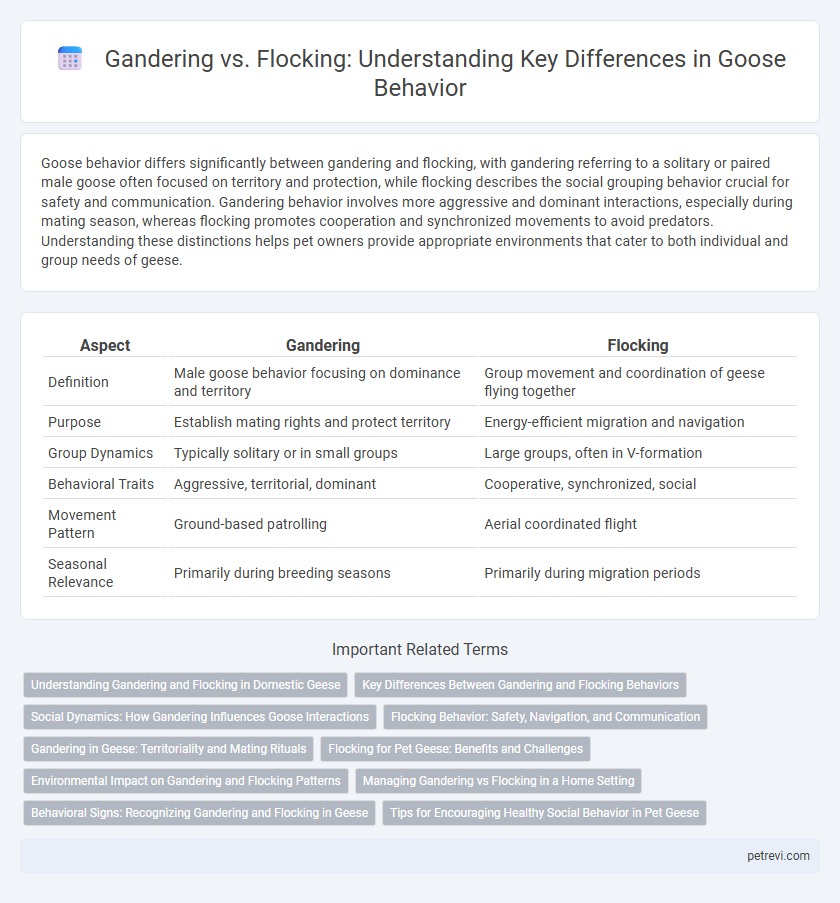Goose behavior differs significantly between gandering and flocking, with gandering referring to a solitary or paired male goose often focused on territory and protection, while flocking describes the social grouping behavior crucial for safety and communication. Gandering behavior involves more aggressive and dominant interactions, especially during mating season, whereas flocking promotes cooperation and synchronized movements to avoid predators. Understanding these distinctions helps pet owners provide appropriate environments that cater to both individual and group needs of geese.
Table of Comparison
| Aspect | Gandering | Flocking |
|---|---|---|
| Definition | Male goose behavior focusing on dominance and territory | Group movement and coordination of geese flying together |
| Purpose | Establish mating rights and protect territory | Energy-efficient migration and navigation |
| Group Dynamics | Typically solitary or in small groups | Large groups, often in V-formation |
| Behavioral Traits | Aggressive, territorial, dominant | Cooperative, synchronized, social |
| Movement Pattern | Ground-based patrolling | Aerial coordinated flight |
| Seasonal Relevance | Primarily during breeding seasons | Primarily during migration periods |
Understanding Gandering and Flocking in Domestic Geese
Gandering refers to the behavior exhibited by male domestic geese, known for their territorial aggression and protective instincts toward their flock. Flocking describes the social behavior of domestic geese when they move and feed together, enhancing safety through collective vigilance. Understanding these behaviors helps optimize management practices and improve the welfare of domestic geese in farming environments.
Key Differences Between Gandering and Flocking Behaviors
Gandering behavior in geese primarily involves territorial defense and mate guarding during the breeding season, characterized by aggressive posturing and vocalizations to protect nesting sites. Flocking behavior, on the other hand, refers to the social grouping of geese outside the breeding period for migration, foraging, and predator avoidance, emphasizing coordinated movement and communication within large groups. Key differences lie in the purpose--gandering focuses on reproductive success and territory control, while flocking enhances survival through collective vigilance and efficient resource utilization.
Social Dynamics: How Gandering Influences Goose Interactions
Gandering significantly shapes social dynamics within goose communities by establishing hierarchical structures that influence group cohesion and mating behaviors. These dominant males often assert control over territory and flock movement, directly affecting the flock's stability and foraging efficiency. Understanding gandering provides key insights into the complex interplay between individual roles and collective behavior in goose populations.
Flocking Behavior: Safety, Navigation, and Communication
Flocking behavior in geese enhances safety by reducing individual vulnerability through coordinated group movement, which deters predators effectively. This behavior facilitates navigation by enabling geese to follow experienced leaders, optimizing migration routes and conserving energy via aerodynamic formations like the V-shape. Communication within flocks relies on vocalizations and synchronized movements, ensuring alignment and timely responses to environmental threats.
Gandering in Geese: Territoriality and Mating Rituals
Gandering behavior in geese is characterized by strong territoriality, where male geese aggressively defend nesting sites to secure optimal breeding conditions. This territorial defense plays a crucial role in mating rituals, as dominant ganders attract females by demonstrating their ability to protect and provide a safe environment. Unlike flocking, which is primarily for social cohesion and migration, gandering focuses on reproductive success through individual territorial control and mate guarding.
Flocking for Pet Geese: Benefits and Challenges
Flocking behavior in pet geese promotes social bonding, natural communication, and collective protection, which enhances overall well-being and reduces stress. Maintaining a consistent flock requires adequate space, balanced nutrition, and monitoring for dominance disputes to prevent injury. Understanding flock dynamics is essential for optimizing care and ensuring a harmonious environment for pet geese.
Environmental Impact on Gandering and Flocking Patterns
Gandering and flocking behaviors in geese are significantly influenced by environmental factors such as habitat availability and food resources, which dictate migration routes and resting site selection. Changes in climate and urban development can alter these patterns, leading to shifts in geese congregation areas that impact local ecosystems through nutrient deposition and vegetation grazing. Understanding these environmental impacts is crucial for managing geese populations and mitigating their ecological effects in both natural and urban landscapes.
Managing Gandering vs Flocking in a Home Setting
Managing gandering versus flocking in a home setting requires understanding their distinct social behaviors and space needs. Ganders often display territorial aggression during mating seasons, necessitating separate enclosures or barriers to prevent conflict. Flocking behavior encourages social bonding and reduces stress, so providing ample space and environmental enrichment fosters natural group dynamics among domestic geese.
Behavioral Signs: Recognizing Gandering and Flocking in Geese
Gandering behavior in geese is characterized by solitary males asserting dominance through hissing, wing flapping, and territorial displays, signaling readiness to mate or defend territory. Flocking behavior involves group cohesion, where geese communicate through honking and coordinated movements to enhance safety and foraging efficiency. Recognizing these behavioral signs helps differentiate individual aggression from social bonding within goose populations.
Tips for Encouraging Healthy Social Behavior in Pet Geese
Gandering displays dominance and territoriality, while flocking represents cooperative social behavior essential for pet geese's well-being. Encourage healthy social interactions by providing ample space, secure nesting areas, and consistent group routines to minimize aggression and promote bonding. Observing body language and separating overly dominant ganders can help maintain harmony within the flock environment.
Gandering vs Flocking for Goose Behavior Infographic

 petrevi.com
petrevi.com